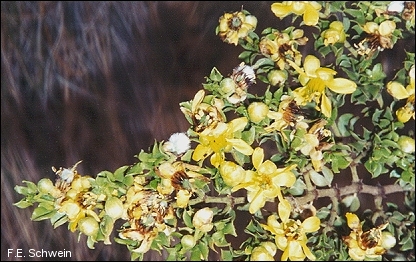
According to Tohono O'odham and Pima elders, Earth Maker began to flatten the soil like a tortilla, then shaped it into a mound from which grew Creosotebush. A tiny, scaly insect grew from its branches using the Creosotebush's resin to produce its own covering of lac. Earth Maker gathered the gum-like lac, and while singing, formed the mountains. The mountains hardened like shellac and made a hard crust for the earth, with the space above becoming the sky.
We can be reminded of this creation story when we look at the slightly shiny, olive-green plants that dot our landscape. In fact, these plants are found in about one-fourth of Mexico and about 70,000 square miles of the U.S. Southwest.
Paleoecologists confirm that Creosotebush existed near the Little Colorado River more than 17,000 years ago and speculate that it migrated up from South America during the Pleistocene and began to spread as the Ice Age waned. It meandered across the Sonoran Desert and spilled into the northern Chihuahuan Desert about 4500 years ago.
Can it be that as the Creosotebush thrives, Earth Maker is still
singing about the glories of creation?
![]()
Contributor: Florence E. Schwein, University of Texas at El Paso.
Desert Diary is a joint production of the Centennial Museum and KTEP National Public Radio at the University of Texas at El Paso.

Flowers, fruit, and leaves of the Creosotebush (Larrea tridentata). Photograph by Florence E. Schwein.
Nabhan, G. P. 1985. Gathering the desert. University of Arizona Press, Tucson, 209 pp.
Tweit, S. J. 1998. Seasons in the desert: A naturalist's notebook. Chronicle Books, San Francisco, 224 pp.